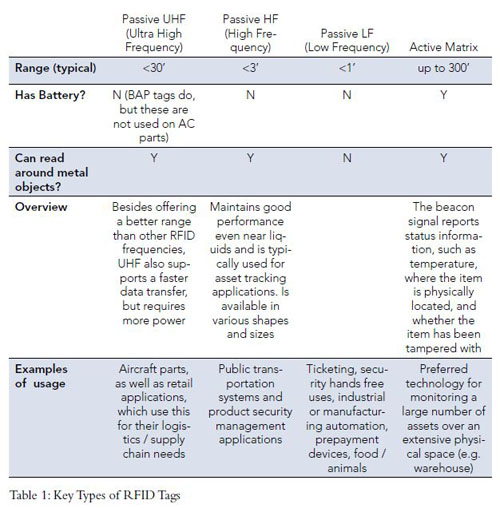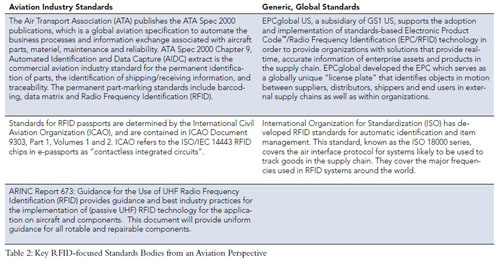
RFID Tags the Aerospace Market

By John Pawlicki
For the past decade or so, radio-frequency identification (RFID) has slowly crept into various aspects of the aerospace, aviation and travel industries. It began (mostly) in the logistics and shipping industries, helping track pallets and shipping containers, and then moved into the supply chain due to efforts by the U.S. Department of Defense and some of the electronics industry. Lately, RFID tags have been supplementing or replacing bar codes on higher-value aircraft parts on newer aircraft models, as well as storing parts records on aircraft.
In an era where pervasive connectivity due to wireless Internet is providing aviation personnel and traveling passengers with a means of accessing information anywhere and everywhere, RFID provides a means of tracking assets remotely. RFID is used not only in helping track and trace assets (supply chain/shipping, tracking tools in a building, identifying consumables and perishables, and ID badges, among other uses), but is directly involved in further connecting our world by providing greater access to information about these assets wherever they may be located, be it inside an aircraft, or in a warehouse located halfway around the world.
Before we jump into our commentary and entertain you with our RFID-enabled thoughts, I’ve provided a greatly-condensed primer on this technology as it relates to aviation.

Quick Overview on RFID Technology
The text box to the right covers the basics on RFID technology, which essentially consists of two basic components, the RFID tag, and the reading device (reader), as well as software which supports it use.
From an oversimplified point of view, RFID tags come in two basic types and are as follows:
• Passive: Typical passive tags do not contain a battery; the power to the tag is supplied by the reader and stored in a capacitor. When radio waves generated by a reader are detected by a passive RFID tag, the tag’s antenna forms a magnetic field which supplies power to the circuit. The tag then dispatches the data encoded in the tag’s memory. Some newer passive tags use a battery-assisted passive (BAP), which has a small battery on board that is activated when in the presence of a RFID reader. Passive RFID tags can transmit a signal up to only several meters (but do not need to have a line-of-sight as barcode readers require). Aircraft parts use these type of tags (with no battery).
• Active: These tags have an on-board battery that always broadcasts or beacons the signal that lasts between three and eight years, and which intermittently broadcast a coded signal which is decoded by a reader. Active RFID deployments can monitor large numbers of items at distances up to 300 feet, eliminating the need to make routine, physical inspections or audits of inventory. Active RFID can make use of various types of wireless technology, including Wi-Fi, short-range radio and even cellular, to send signals.

The term ‘RFID reader’ is often used as a generic term to describe not only readers, but RFID interrogators, RFID scanners and RFID reader writers. Which to use is dictated by the application or solution they are applied to, as indicated in table one.
RFID is a rapidly-evolving technology, and table one might not reflect specialized applications which are pushing the envelope. As these types of applications enter the mainstream aerospace/aviation environment, expect some interesting advancements in not only how tags and readers are deployed, but in how information generated from these tags affects our business processes. Once organizations become accustomed to greater data automation and having more trust in the data obtained, this will affect an ever larger amount of business functions at all aviation enterprises.
Aerospace-related RFID Standards
In order for any technology to blossom within any market, common standards and policies must exist, especially when assets (aircraft parts, shipments/pallets/containers, ID badges for personnel, etc.) move from one organization to another. Regulatory guidance in aviation is also key, due to the safety factors our industry requires. The FAA has provided an advisory circular on applying RFID tags on working aircraft, AC 20-162, “Airworthiness Approval and Operational Allowance of RFID Systems,” dated Sept. 22, 2008. This advisory states that passive devices are allowed as long as they are not interrogated in flight or when an aircraft is on an active runway or taxiway. Essentially, it allows aircraft to make use this technology without the need to recertify/requalify aircraft.
There are several sets of standards which have been defined by various organizations for the use of RFID in the aerospace/aviation market, two of the most important being the ATA and EPCGlobal (an organization set up to achieve worldwide adoption and standardization of Electronic Product Code (EPC) technology, and to create both a worldwide standard for RFID). A greatly condensed table of key standards bodies that affect aviation directly are shown in table two.
While RFID has been used in travel (passports, baggage tags) and logistics/cargo/supply chain (tracking shipping containers/pallets/items), and the retail markets for some time now, it has moved a bit slower in the aerospace world. The U.S. Department of Defense was one of the main proponents of this technology, and its mandates helped RFID leapfrog into a more mature market in a short time, helping drive not only adoption, but also helping drive some of the initial standards efforts by providing lessons learned.
Aircraft Parts Going Digital
Aircraft parts are emerging as one of the key growth markets in aviation for RFID technology, with key parts on new aircraft being tagged. As this movement is still in its infancy, it has evolved quite a bit in its short time. Both Airbus and Boeing have announced their intentions to use RFID for some time now, and both have had publicly-announced various pilot projects. Airbus has announced that it expects to have more than 3,000 aircraft parts tagged on the forthcoming A350 (due out in 2013), and may eventually have up to 12,000 parts tagged on this aircraft. This will also migrate to other Airbus aircraft. Business jet OEMs have also been studying this technology for their aircraft as well.
Some of the initial concerns over pricing per tag, weight (typically between five and 10 grams per passive UHF tag), and support needs (minimal) have been solved to a large degree. RFID application providers have been reducing costs and increasing the capabilities of tags rather rapidly in recent years.
One example of this is Tego, which has been working on taking RFID users beyond the notion that a tag is there to provide an identification number and into the concept of “smart assets.” With more memory and intelligent computation and processing available right on the tag, tagged assets provide more information directly. Key or critical data associated with an asset can be stored right on the asset itself, eliminating the need to perform a database lookup to a remote location, and mitigates the potential issue of associating data with the wrong asset.
“Once you start having the conversation about smart assets, people quickly realize they’ll probably want their data to be there and be reliable for a long time,” says Bob Hamlin, CTO of Tego. “Unlike in retail (where RFID has gotten its popularity), where assets are only supposed to be in-house for a few weeks at most, maintenance shops are dealing with parts that live on an aircraft for 20 or 30 years, and might be in inventory for just as long.”
The flash-based memory (which records data using charge storage) can only keep its data reliably for a few years, much short at high temperatures. Tego had to invent a new type of memory that could work in the low-power RFID environment and at the same time provide reliable storage for 30 years at high temperature (and around 300 years at room temperature). Expect further advancements as this technology enters commercial deployment and customers begin adapting their business applications to take advantage of new capabilities gleaned from such tags and the information they provide.
While many of the RFID solution providers are focused on applying new parts to new aircraft, other vendors are developing solutions for tagging existing aircraft parts on legacy commercial aircraft. This approach is taken by Technology Solutions and its partners to provide stand-alone, PC-based solutions for aviation suppliers or airline back shops.
“End users would like to be able to store maintenance history and other timely data, to better track when parts have been inspected or maintained,” says Jon Andresen, president of Technology Solutions LLC. “But, the market is still in the early adoption phase, with small numbers of early adopters venturing into RFID, and will take time to mature.”
Aerospace thrives on competition, with vendors cooperating on standards development and educating the market on the core concepts, but with competitors taking differing approaches on how to take advantage of these standards. While this may cause potential customers to “do their homework” more in order to properly evaluate a plethora of solutions, it will also drive further developments as the industry comes to better understand how to make use of this technology.
Identifying the Future
RFID is slowly entering daily use in the commercial aviation world, and will undoubtedly enter regional, business and general aviation as well. It has begun changing how aircraft will be managed, and how components will be tracked, as well as how this information is extracted (with more automated data transfers reducing the need for manual processing).
Aviation maintenance personnel will need to become more familiar with RFID technologies and components (readers, differing types of tags, network connections and how wireless transmissions can be affected) to better support not only aircraft, but their customers in general. This illustrates why all aviation personnel need be better aware of information technologies and how the march of communications, networking and computing in general need to become part of everyone’s skillset. While this is not expected to be an overly onerous set of changes for some, companies and individuals who are best able to make use of information technology will benefit the most.
 John Pawlicki is CEO and principal of OPM Research. He also works with Virtual Security International (VSI), where he consults to the DOT’s Volpe Center, handling various technology and cyber security projects. He managed and deployed various products over the years, including the launch of CertiPath (with world’s first commercial PKI bridge). Pawlicki has also been part of industry efforts at the ATA and other related groups, and was involved in the effort to define and allow the use of electronic FAA 8130-3 forms. He recently completed his writing of the ‘Aerospace Marketplaces Report’ which analyzed third-party sites that support the trading of aircraft parts. For more information, visit OPMResearch.com.
John Pawlicki is CEO and principal of OPM Research. He also works with Virtual Security International (VSI), where he consults to the DOT’s Volpe Center, handling various technology and cyber security projects. He managed and deployed various products over the years, including the launch of CertiPath (with world’s first commercial PKI bridge). Pawlicki has also been part of industry efforts at the ATA and other related groups, and was involved in the effort to define and allow the use of electronic FAA 8130-3 forms. He recently completed his writing of the ‘Aerospace Marketplaces Report’ which analyzed third-party sites that support the trading of aircraft parts. For more information, visit OPMResearch.com.
Radio-Frequency Identification (RFID) is a technology that uses radio waves to transfer data from an electronic tag, called RFID tag or label, attached to an object, through a reader for the purpose of identifying and tracking the object. Some RFID tags can be read from several meters away and beyond the line of sight of the reader. The application of bulk reading enables an almost-parallel reading of tags.
The tag's information is stored electronically. The RFID tag includes a small RF transmitter and receiver. An RFID reader transmits an encoded radio signal to interrogate the tag. The tag receives the message and responds with its identification information. Many RFID tags do not use a battery. Instead, the tag uses the radio energy transmitted by the reader as its energy source. The RFID system design includes a method of discriminating several tags that might be within the range of the RFID reader.
Source: Wikipedia
“Birth & Maintenance Records” Stored on RFID Tags
Tags on aircraft parts can contain birth records, repair and certification history, actions taken, time-on-shelf, no fault founds history, among other information.
This will assist in managing parts better, but also in combatting counterfeit parts, since we can better identify individual, serialized parts which have RFID tags, and match them to their associated regulatory documentation. Combining this with parts data stored in databases, will provide the industry with an increased means of potentially eliminating suspect parts.
